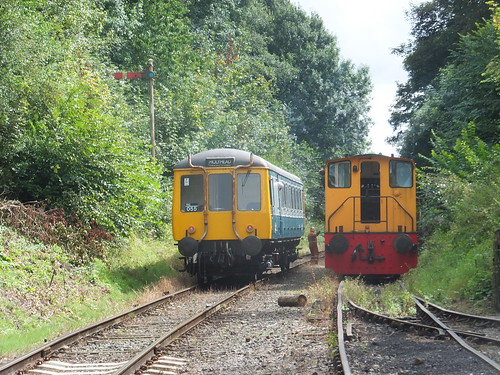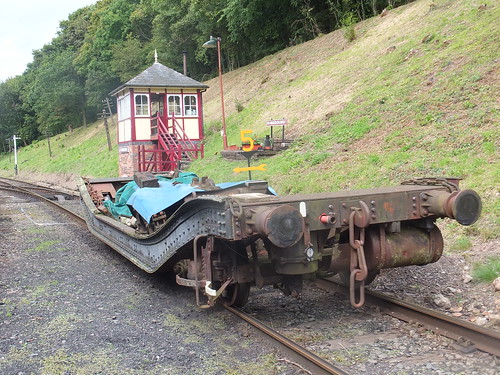Wednesday 13th August 2014
It wasn't a particularly busy day so the single-car railcar (the 'Bubblecar') provided plenty of capacity. Had we run out of space, one car of the 2-car railcar was available on the DMU siding and could have been used to provide more seating. As I've commented before, the other 'half' of the 2-car railcar is 'out of traffic' receiving various body and related repairs.
At Shackerstone, with the coaches for the locomotive-hauled train stabled in Platform 2, when the diesel railcar is in platform 1 awaiting its next trip nothing else can move. After our third round trip, Adrian said he wanted to do a shunting move and could we move up to the section signal out of the way for a few minutes? The Guard and I immediately agreed, arrangements were made with the Signalman and I took our empty railcar up to the section signal. This allowed Simon to drive the diesel shunter through the now-empty Platform 1 to the DMU Siding and onto one car of the 2-car railcar and, behind it, a 'Lowmac' wagon which is what they were really after. Once Adrian had coupled up and released the handbrakes, Simon drew down clear of the crossover and, when the Signalman had reversed the crossover and cleared the signal, propelled the wagon and Railcar towards the 'Bubblecar'. The 'Lowmac' was 'tied down' by applying its handbrake and uncoupled from the railcar. Simon then put the railcar back where he found it.
 With the 'Bubblecar' standing at the Section Signal, the Guard looks on as Adrian and Simon 'park' the railcar back in the DMU Siding.
With the 'Bubblecar' standing at the Section Signal, the Guard looks on as Adrian and Simon 'park' the railcar back in the DMU Siding.
The code 'Lomac' is a Low Machinery wagon. The depression or 'well' in the chassis allows taller loads to be carried without exceeding the loading gauge. The vehicle was originally vacuum braked. The vertical brake cylinder and horizontal vacuum reservoir are visible in the picture below, but the flexible brake hose has been removed.
 Detail of the 'Lowmac' with the handbrake applied. The coupling is an 'Instanter'.
Detail of the 'Lowmac' with the handbrake applied. The coupling is an 'Instanter'.
The diesel shunter then picked up the 'Lowmac' and returned to the north end, freeing Platform 1 so that the 'Bubblecar' could pick up the passengers for the last trip of the day.
Wednesday 27th August 2014
Two days previously (the August Bank Holiday Monday), I'd been driver of the steam train at the Battlefield Line when it rained most of the day, so I wasn't sure what to expect. I'd taken my heavy woollen overcoat, just in case, but the sun came out and it was a very pleasant day. The sun seemed to attract the passengers because the 'Bubblecar' was quite well loaded throughout the day.
 The 'Bubblecar' simmers in the sun at Shenton.
The 'Bubblecar' simmers in the sun at Shenton.
On a steam locomotive, you're a little isolated from your passengers and you're busy all the time but, with a diesel railcar, there's more time to talk to passengers. At one end of the 'Bubblecar', the cab is separated from the passenger compartment only by a glass panel. When I was young and British Railways first introduced these diesel railcars, I always tried to get a seat immediately behind the driver. Not only did it offer excellent views down the track ahead, but you could watch exactly how the driver operated the controls. I never thought then I'd one day drive myself.
If a person shows a particular interest, I often allow them to travel on the 'jump seat' in the cab, although I'm reluctant to converse except in stations - it's an awesome responsibility driving the public, requiring concentration. In stations, children are often welcomed into the cab. During the day, lots of our passengers visited the cab - young people, mature people and some of our volunteers.
Preserved railways are totally dependent upon their volunteers and the 'Wednesday Gang' were on site carrying out some of the myriad tasks needed to keep the railway running. I noticed creosoting, fence repairing, platform white line painting being carried out amongst other tasks including running shops, providing refreshments, dealing with tickets and, of course, operating the railway.
 Members of the 'Wednesday Gang' enjoy lunch in the sun at Shenton, watched by volunteer Bernard.
Members of the 'Wednesday Gang' enjoy lunch in the sun at Shenton, watched by volunteer Bernard.
Many passengers reported that they'd enjoyed their trip, making it all worthwhile and I certainly enjoyed the day.
Related posts in this blog
All my posts on the Battlefield Line (with links to pictures) can be found here.
My pictures
The Battlefield Line, 2014.
